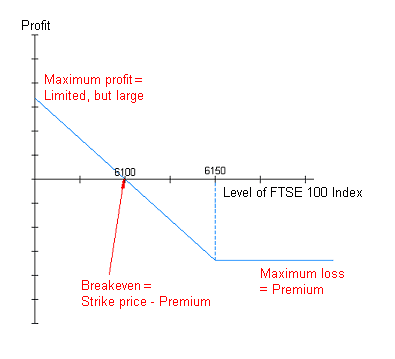Buying a Put
This is a bearish strategy. You might employ this Option strategy if you thought the underlying market was likely to fall.
Consider someone buying a 6150 Put Option on the March FTSE® 100 Index for a premum of 50 points. This means he has the right to sell the FTSE® at 6150 on the expiry date in March (which is the third Friday in March).
Let's now look at some different levels of the index on the third Friday in March and how they affect the value of the Option at expiry.
Let's say that the expiry price of the March FTSE® is 6030. The right to sell at 6150 must be worth 120 points. The Option cost 50 points of premium, so that overall the profit is 120 - 50 = 70 points. With a spread bet this would be 70 times the bet size. So at, say, £2/point, this would mean a profit of £140.
If the FTSE® had instead expired at 6180, the Option would be worthless: there would be no value in the right to sell lower than the current price of the index. The loss would be the premium: 50 points.
Plotting the profit/loss profile of this position at expiry:

The breakeven point and the maximum profit are calculated by subtracting the premium from the strike price. For the example, this is 6150 - 50 = 6100. In other words, the premium first needs to be 'recovered' before the position starts making a profit, just as for the scenario when buying a Call.
Unlike buying a Call, however, the maximum profit is not unlimited. This is because the underlying cannot fall below zero. At this level, the FTSE® can, theoretically, be bought for nothing and then sold at 6100. Taking into account the 80 points of premium that have been expended in buying the Put, the maximum profit will be 6100 points.
Risk
The risk is limited to the premium when buying a Put, the same as when buying a Call.
Reward
The value of the right to sell increases as the underlying price drops. The maximum profit is achieved if the underlying asset price falls to zero.